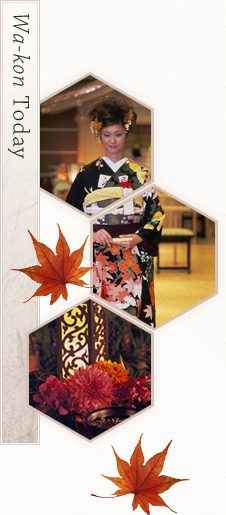Today, Wa-kon is used as general term for a wedding incorporating “ wa ” or Japanese style in a very broad sense – including customs indigenous to Japan, wearing Japanese clothes, partaking of Japanese food, Japanese-style coordination, shinzen ceremonies in Shinto shrines, butsuzen ceremonies in Buddhist temples, and so on.
The recent Wa-kon boom is part of a re-awakened interest in typically Japanese culture, as witnessed in the “Japan boom” or “Japan cool” trends. The Japanese of today seem to have found new attraction in Japan’s history and traditions, and have started to notice the positive qualities of things like the kimono and shinzen weddings. Qualities like beauty, elegance and gracefulness are the spirit of ‘ wa ’ that resonates in the hearts of Japanese women. Perhaps it is no surprise, then, that the boom mainly involves Japanese women.
In the following, we will introduce some of the main trends and styles of Wa-kon in recent times.
This is a Shinto-style wedding ceremony held in a shrine or sanctuary, officiated by a Shinto priest. While there are differences in the ceremony depending on the particular Shinto sect, the most common style is for the bride to wear a wig and watabōshi (silk veil), tsunokakushi headdress and shiromuku gown, and for the groom to wear the monpuku , a black crested kimono . Recently the kurohikisode full-length black kimono is often accompanied by a wig and tsunokakushi , while women who prefer not to wear wigs can have their hair dressed in western style. These examples illustrate the growing diversity of ceremonies that can be permitted.
Although no bride walks down the aisle in a kimono , there are some signs of Wa-kon in chapel weddings. For example, the bride sometimes changes to a kimono for the reception. This style is now rapidly increasing in popularity, including the element of show when the bride appears in a gorgeous modern Japanese costume after fulfilling her dream in a wedding dress.
In the jinzen style wedding, there is no separate location for the ceremony; the couple exchange vows in front of their guests in the reception venue. Many venues allow jinzen-shiki ceremonies in kimono , or small ceremonies attended by family members only. In some cases, this style is chosen on the wishes of parents or grandparents, but it is now increasingly the case that the bride and groom prefer jinzen-shiki because it seems “more their style”. As such, there is now a tendency for jinzen-shiki ceremonies to incorporate creative elements, rather than the couple merely reading prescribed wedding vows.
A style of reception now growing in popularity is one in which ‘ wa ’ elements are incorporated in the atmosphere, table coordination, flower displays, stage management and other aspects of the reception venue itself.
While couples are increasingly choosing proper shinzen-shiki and Japanese dress in international weddings, this may result from a deeply rooted attitude of respecting a country’s culture. Perhaps the Japanese-style wedding ceremony provides an opportunity for people to reaffirm contact with the culture of their own country, given the trend towards globalization.
















